With the explosion of data caused by social media, mobile systems, digitization of paper documentation and the strong interest in Service Oriented Architecture (SOA) and Software as a Service (SaaS), companies are struggling to achieve consistent reporting and ensure compliance with regulations and legislation . All of this has led to a great interest in knowing what MDM (Master Data Management) is and why it is important for an organization.
What is MDM
An MDM is a comprehensive method that allows a company to unify all its critical data into a single repository . This repository is called a Master File and once implemented and put into operation, it becomes the common point of reference, capable of eliminating redundancy and inconsistency of different versions of data in the organization. When done correctly, an MDM:
- Simplifies data exchange between staff and different departments, increasing the quality and consistency of information.
- It facilitates working with multiple system architectures, platforms and applications since most software systems have lists of data that are shared and used by several of the applications that comprise it.
Although there is much confusion surrounding ig database master data and its definition, in business environments it is common to see questions asking ” what is MDM?”, master data is often one of the key assets of an organization, so much so that it can even motivate large transactions, such as mergers and acquisitions , which aim to access customer master data.
In addition to customer master data, there are several other types of data; the most typical are product, employee, location, or asset. However, identifying the data elements that need to be managed by a master data management system is much more complex than these definitions and requires a more in-depth analysis.
The importance of Master Data Management
Companies today strive to become more agile by implementing information systems that support and facilitate changes in business requirements . As a result, managing information about products, customers, etc. has become increasingly important. But there are two problems:
There are still many companies that do not base their decisions on all their information, but rather on a very small percentage of their information assets.
According to a recent Forrester report :
- Most companies estimate that they are analyzing only 12% of their data , so they could be missing out on the perspective that the other 88% of data would provide.
- Organizations believe they are losing more than 27% of their revenue due to inaccurate master data.
Organizations 3
work with many different information storage systems, resulting in overlapping, redundant, and inconsistent data.
For example:
- Definitions of common terms content marketing ideas for e-commerce websites that may differ between systems.
- Different rules for data validation, cleansing, etc. may apply in different systems.
Obtaining consistent, complete and relevant master data is not so simple. Not even today, when its importance is well known. Because the existence of master data has been known for a long time, but until recently organizations were not so aware of the fact that:
- They need MDM systems to manage their information.
- Master data is special data.
- Its relevance to business is unquestionable.
You may be interested in reading:
A company’s most critical information must be well managed ar numbers to ensure that the MDM system provides clean and consistent master data to the entire organization. Master data quality is one of the main objectives of MDM enablement of a company. It is about ensuring that master data has all the necessary attributes:
- Accuracy
- Integrity
- Reliability
- Coherence
- Relevance
- Update
Answering the question “what is MDM?” is about logic, simplification of complexity and information architecture. In an organization, the master data system must be flexible and well managed so that, acting as a system of record or a reference system, MDM is able to provide authorized data to all business users in their interaction with any application.

